Despite being nine-time African Cup of Nations finalists, winning four, Ghana are relative newcomers to the FIFA World Cup. First qualifying for the prestigious tournament in 2006, the Black Stars then competed in two further World Cups in 2010 and 2014 before failing to qualify for the 2018 edition.
Bringing the youngest team at the 2006 tournament, Ghana progressed beyond the group stage but were beaten by Brazil in the round of 16. The 2010 World Cup was the first ever held in Africa and Ghana’s inspiring performances in South Africa led to them becoming only the third African team to reach the World Cup quarter-finals.
In a heart-wrenchingly cruel quarter-final fixture against Uruguay, the Black Stars were knocked out in a penalty shootout following a controversial goal-preventing handball from Uruguay striker Luis Suárez. In 2014, Ghana registered just one point in a tough group with Germany, Portugal, and the United States.
Ghana’s preparations for the 2022 World Cup in Qatar have been far from ideal. Milovan Rajevac, the manager that guided Ghana to their historic quarter-final in 2010, returned to manage the Black Stars in September 2021. However, the Serbian was sacked in January 2022 after a dreadful AFCON campaign. He was replaced by Otto Addo, who appeared as a player at Ghana’s first-ever World Cup in 2006.
Rather unexpectedly, Addo’s Ghana beat a strong Nigeria squad on away goals in the World Cup qualification play-offs to earn a spot in Qatar. The Black Stars’ reward is the opportunity to get revenge on Uruguay, alongside facing Portugal’s talents and Heung-min Son’s South Korea in the group stage.
Another obstacle but overall positive for Ghana is the recent influx of dual nationals to the squad. Improving the quality of players available for Addo to select, the new players lack experience and cohesion with the team and international football ahead of the World Cup.
The English-born duo of Brighton’s Tariq Lamptey and Bristol City’s Antoine Semenyo have joined the squad along with Club Brugge defender Denis Odoi. Hamburg attacker Ransford-Yeboah Königsdörffer and Karlsruher centre-back Stephan Ambrosius were both Germany under-21 internationals prior to their recent Ghana call-ups.
Southampton centre-back Mohammed Salisu has finally joined the Black Stars after years of declining call-ups to focus on his club career. However, the most notable recent inclusion is Athletic Club’s Iñaki Williams. Despite being capped by the Spanish national team, Iñaki declared to play for Ghana at the World Cup, unlike his younger brother Nico, who selected Spain.
This tactical analysis in the form of a scout report will look at how Otto Addo will attempt to mould this new-look squad into a team capable of progressing out of their challenging World Cup group.
Predicted Starting XI
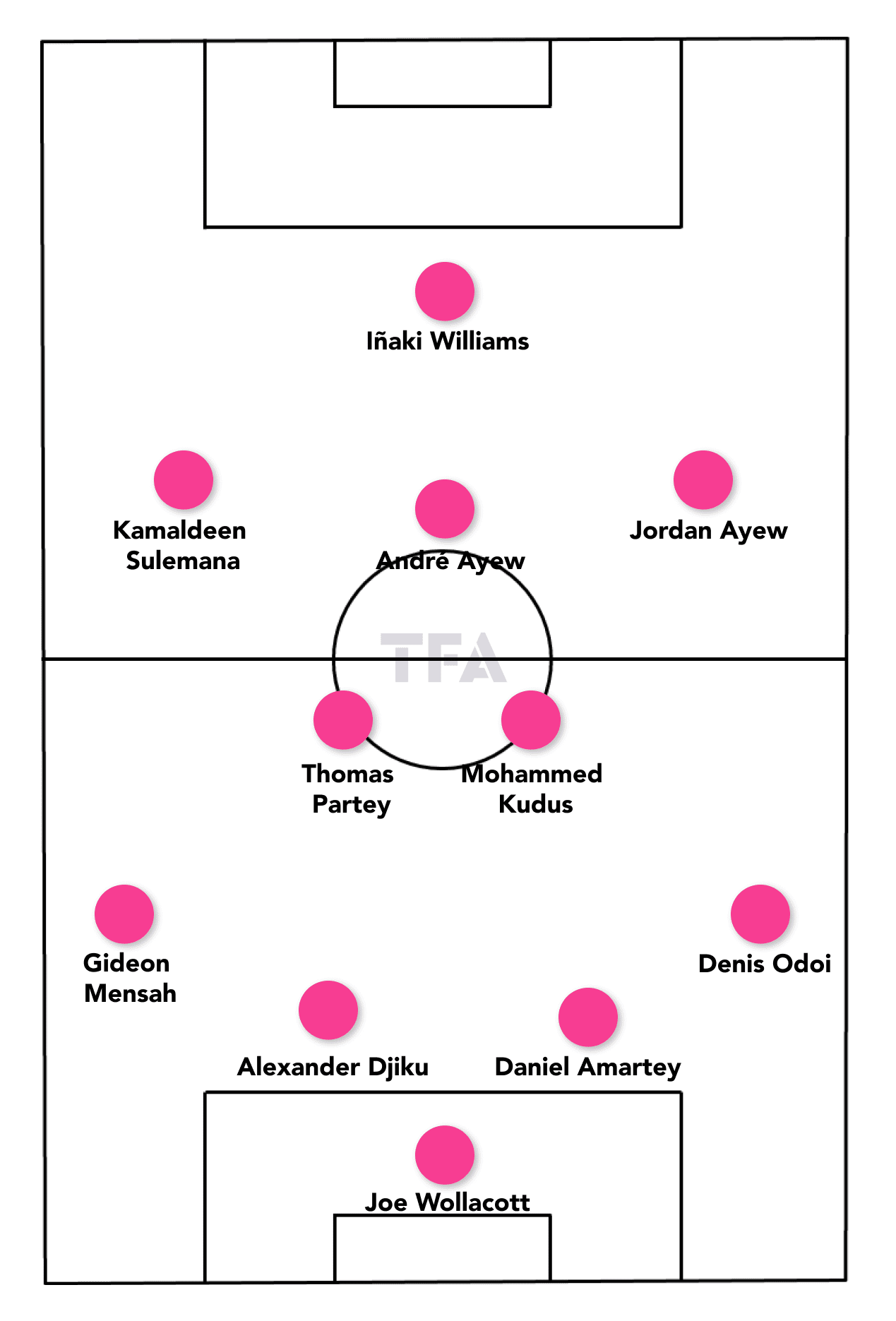
Alongside the diversity and quantity of players, new and old, that Ghana have selected in recent months, Otto Addo’s inconsistent team shapes have made predicting a starting XI more challenging. Addo has deployed the Black Stars in variations of a 4-3-3/4-2-3-1 as well as five at the back formations. Although Addo’s plan is currently unclear ahead of the World Cup, we have tried to predict the starting XI in the image above.
Despite Lawrence Ati Zigi being the Ghanaian goalkeeper performing at the highest level, the St. Gallen #1 has been missing from recent national team squads. As a result, Charlton Athletic’s Joe Wollacott appears to have beaten the more experienced Richard Ofori of Orlando Pirates to start between the sticks. Eupen’s backup goalkeeper Abdul Manaf Nurudeen is expected to be third choice, after beginning his career at the Senegalese Aspire Academy owned by World Cup hosts Qatar.
At right-back, Addo has a new dilemma of choosing between 22-year-old Tariq Lamptey and 34-year-old Denis Odoi. Lamptey has only picked up one cap for the Black Stars, whereas Odoi has collected four. Odoi’s caps include the crucial two-legged tie against Nigeria’s star-studded attacking variety, in which the former Belgium international seemed to have performed well enough to lock down a starting spot prior to Lamptey’s recent call-up.
Although both players are keen to get forward, with Lamptey’s creative ability a great asset, Odoi’s defensive capabilities and maturity will likely see the Club Brugge man start against the likes of Rafael Leão, Heung-min Son, and Nicolás de la Cruz.
Despite their clubs’ abysmal start to the season, Leicester City’s Daniel Amartey and Strasbourg’s Alexander Djiku are expected to start at the heart of the Ghana defence. Amartey’s leadership qualities are essential to Otto Addo achieving defensive solidity, while Djiku offers valuable progressive passing and distribution against South Korea’s press and Uruguay’s relentless centre-forwards.
The most balanced pairing is probably Djiku and Southampton’s Mohammed Salisu, with Salisu being Ghana’s best centre-back. However, his singular cap and the minimal errors from the Amartey-Djiku partnership may leave him on the bench. Auxerre’s Gideon Mensah, quite a well-rounded full-back and another good progressor, will start on the left of the defence.
Arsenal’s Thomas Partey is a crucial element to Ghana’s overall play with his ability in and out of possession. His experience will be vital to fulfil a more disciplined role next to Mohammed Kudus of Ajax.
Kudus’ form at Ajax so far this season has been incredible, albeit as a centre-forward. With the attacking talent at Otto Addo’s disposal, Kudus’ versatility he has shown for Ghana and former club Nordsjælland in particular helps Addo’s capacity to select the Ajax man in a deeper role in a more attack-minded XI. With a player of Kudus’ quality, he must fit into the starting XI somewhere.
The forward line may consist of two players looking to reach milestone achievements in Ghanaian football. Jordan Ayew will be looking to surpass his legendary father Abedi Pele’s goal tally by scoring in Qatar. Three appearances would also take the Crystal Palace attacker into Ghana’s top five capped players of all time. His brother André Ayew, of Qatar Stars League side Al Sadd, needs one cap to become their most capped player ever.
Jordan Ayew would play a similar right winger role to his club side, displaying exceptional defensive work rate whilst also being a potential outlet. Otto Addo seems to be searching for a central role that André Ayew could fulfil. This looks to be behind the striker with the freedom to drift wide or into the Black Stars midfield.
Rennes’ Kamaldeen Sulemana has struggled to make an impression in his appearances for Ghana so far. However, Sulemana’s frightening pace and unpredictable dribbling for opponents will make him a certain threat at the World Cup. Recruit Iñaki Williams is the best striker option for the Black Stars. The Athletic Club attacker is developing into a multifaceted striker, capable of relentlessly gaining territory out of the box whilst always being dangerous inside the box.
The recent number of quality foreign-born and based additions to the Black Stars squad is improving the team but potentially limiting the opportunities available to local-based players. Following news of FIFA paying clubs $10,000 per player each day for the number of days that player is at the World Cup, there are discussions in Ghana that local-based players should be selected in the 26-man squad. Some believe that giving these funds to Ghana Premier League clubs would effectively act as a silver bullet for the under-resourced domestic league.
However, it is unlikely that the Ghana Premier League players would provide greater quality than regular starters in Europe. Asante Kotoko’s 19-year-old goalkeeper Ibrahim Danlad is a good sweeper but naturally has issues claiming crosses standing at 5’10”.
Hearts of Oak left-back Dennis Korsah may be called up to the squad if Reading’s Abdul Rahman Baba is injured. Daniel Afriyie Barnieh has previously been called up, but the 21-year-old Hearts of Oak winger is unlikely to have a place at the World Cup. The Ghana Premier League does produce exciting young players though, with Asante Kotoko’s Isaac Oppong and Bechem United’s Clinton Duodu being two attackers with the potential to feature for the Black Stars in the future.
The figure below displays the ages of players that could potentially be selected by Otto Addo for the World Cup, including Ghana FA targets of Bayer Leverkusen loanee Callum Hudson-Odoi and Crystal Palace’s Jeffrey Schlupp.
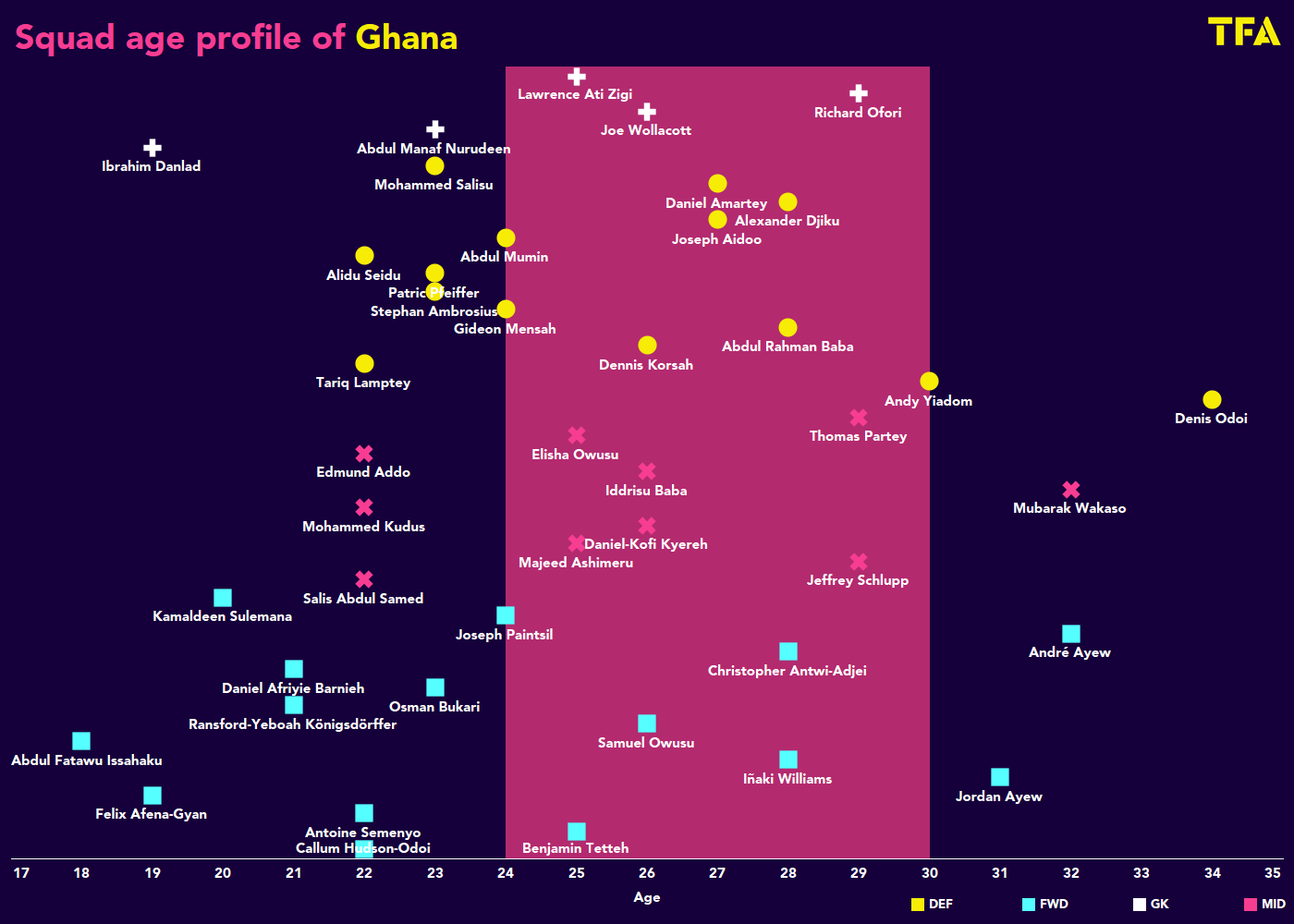
Attacking Phase
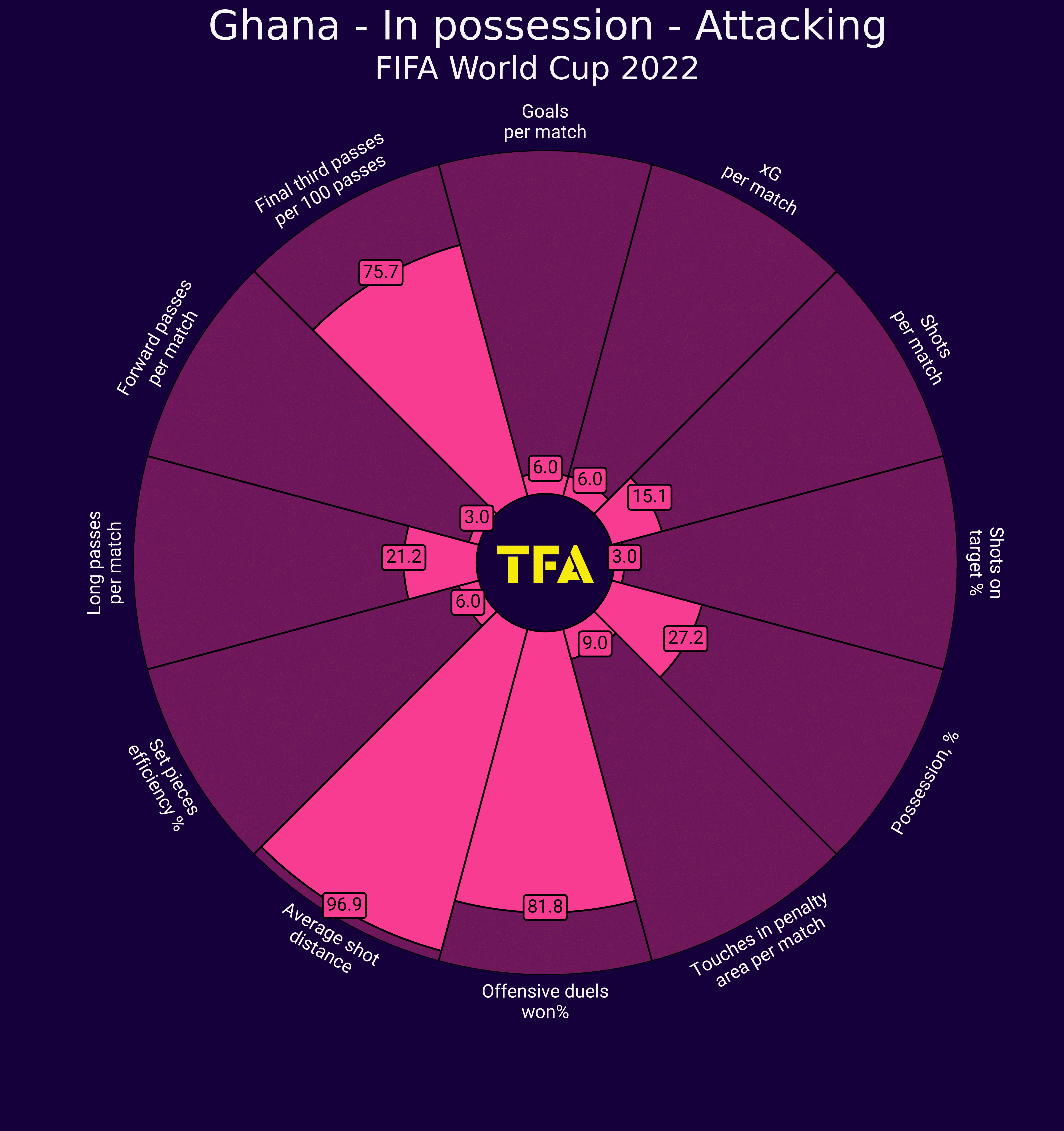
Ghana’s build-up from their goalkeeper is often short, but the receiver depends on the number of centre-backs. With two centre-backs, the goalkeeper will split the centre-backs who will be positioned between the width of the six and eighteen-yard box. The centre-backs will receive, with one full-back in a more advanced position and the other more reserved. The holding midfielder will remain in the pivot space throughout, hoping to draw in an opponent to create space for the central midfielders to receive. However, Arsenal’s Thomas Partey is efficient at dismarking and as a quality ball progressor, his role in build-up will be more than just creating space.
If the Black Stars line up with three centre-backs, the central centre-back will typically receive a short pass from the goalkeeper. Both wing-backs will still be positioned on the border of the defensive third, with a midfielder in the pivot space, looking to overload the build-up phase. This has also occurred in a four at the back, with the Ghana holding midfielder dropping between the centre-back pairing. Occasionally, the central centre-back in the five will push up into the pivot space to provide an additional forward passing option, although this rarely happens unless the versatile Edmund Addo is selected in the back three.
Ghana’s ability to progress the ball into midfield from the build-up phase looks better with a balanced centre-back pairing consisting of a right-footer and a left-footer. Southampton’s left-footer Mohammed Salisu would be the ideal left-sided option, but Otto Addo may not want to break the partnership of Daniel Amartey and Alexander Djiku. Between the sticks, Joe Wollacott has decent distribution over long distances and could help to find outlets like Iñaki Williams to relieve pressure. Eupen’s Abdul Manaf Nurudeen is a weak and loopy kicker which is favourable for opponents.
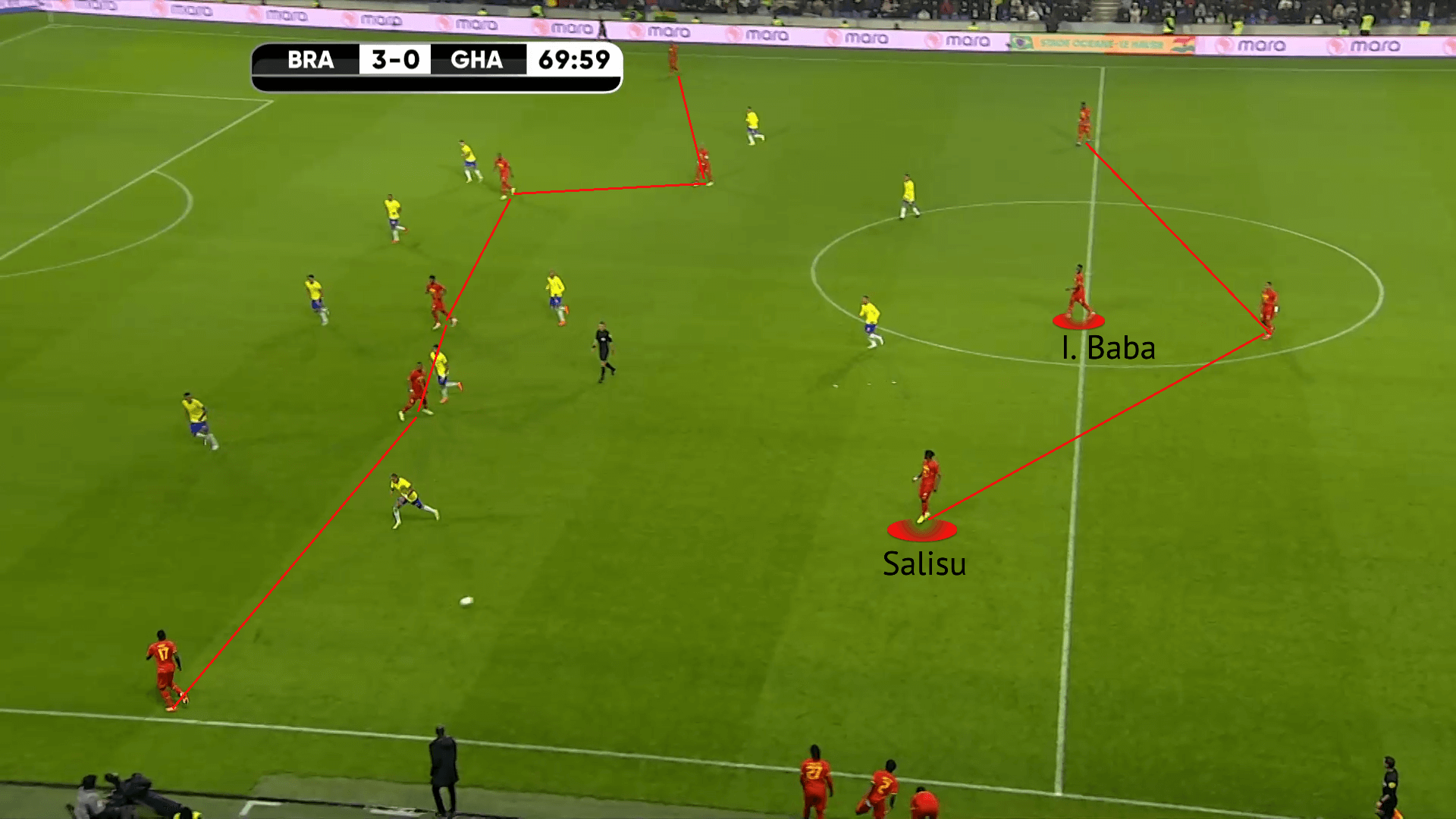
The image above is an example of Ghana’s attacking shape against Brazil. After a tough first half, Otto Addo switched to more of 5-1-2-1-1 formation away from the 4-1-4-1/4-2-3-1 hybrid. Looking to advance into the final third, Ghana’s shape has become a 3-1-6.
The two wide centre-backs are positioned in the half-spaces and can access the wide or central areas, whilst also being an option to recycle possession. Pivot player Iddrisu Baba remains deep, facilitating the wider centre-back positioning and assisting in rest defence against Brazil’s front two in their 4-4-2. Both Ghana wing-backs, Abdul Rahman Baba and Denis Odoi, are holding maximum width to stretch the opposition horizontally and create as much space for the central players as possible.
With a four-at-the-back system, the Black Stars’ shape can have more of a 2-1 base or a 2-4-4. The centre-backs will stay back with the holding midfielder’s position depending on the opposition’s forward line. If the opposition have all players behind the ball, the holding midfielder will step up. With the five at the back, both wing-backs will advance and hold width. However, the four at the back tends to employ more of an adaptive width approach.
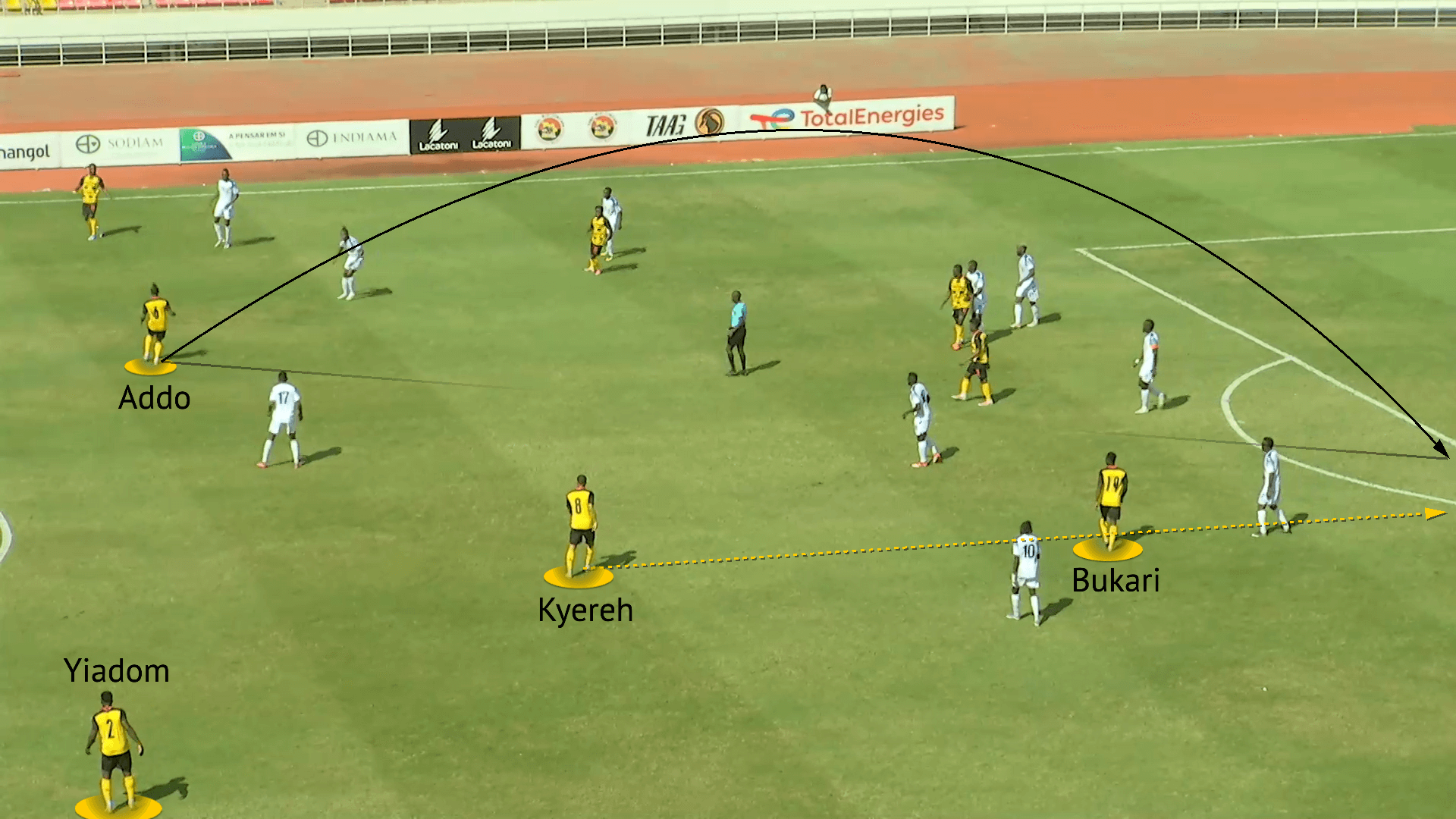
An example of this adaptive width can be seen above against the Central African Republic. Left-back Gideon Mensah is the widest player on that flank with winger Joseph Paintsil inverting. However, on the right side, Ghana’s wide players have adapted their width against the opponent’s defensive structure. Winger Osman Bukari has taken up a more threatening position for off-the-ball movements, with the ability to dash in behind or drop to rotate with attack-minded midfielder Daniel-Kofi Kyereh.
The Red Star Belgrade winger can also utilise his physical and qualitative superiority regarding his SAQ and dribbling ability to get into wide areas ahead of the opposition full-back if needed. Right-back Andy Yiadom also has a narrow position, which is beneficial for rest defence and could be effective against Uruguay’s inverting wide midfielders. This adaptive width can work well due to the proximity of the players to connect and combine, but the attacks can become congested with no static wide presence providing a switch of play.
The image above shows Ghana in more of a 2-4-4 shape, with a narrow front four occupying spaces ahead of Yiadom, Kyereh, Addo and Mensah. However, there will be instances where the shape becomes a 2-3-5 with a central midfielder joining the front line. Expecting Thomas Partey to be joined by attack-minded midfielders, likely Mohammed Kudus and/or Daniel-Kofi Kyereh, this shape could be seen more frequently with Partey as the pivot. In the example above, Kyereh has used dynamic superiority from midfield to supply depth beyond the front line. Receiving possession off Mensah, Addo turns and launches a pass over the defence towards Kyereh to win Ghana a corner. The image below shows adaptive width again from Ghana in a 4-2-4 looking to get forward quickly.
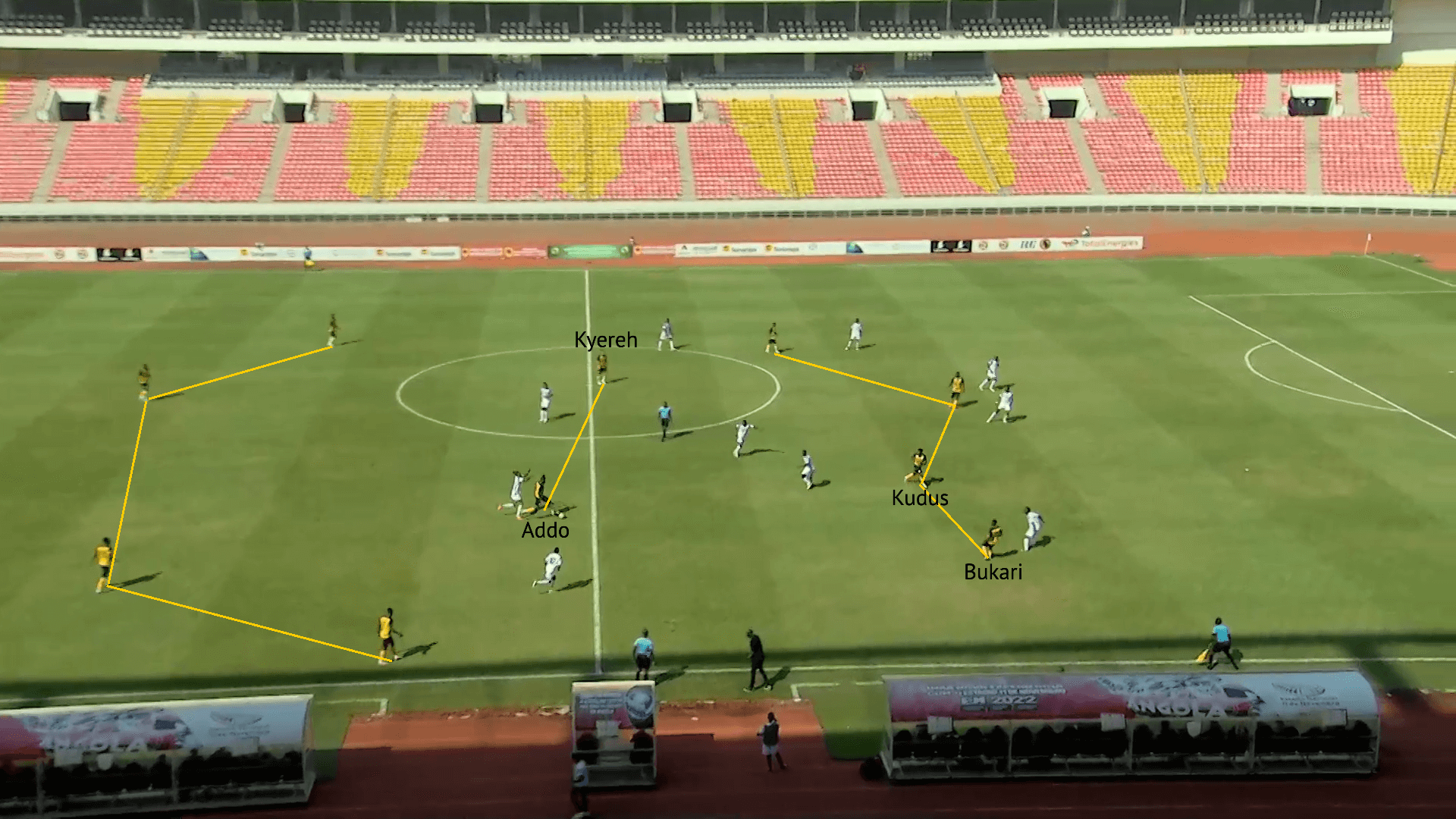
Overall, the Black Stars lack a consistent attacking identity from the build-up phase all the way through to the final third. They only control possession against significantly weaker opponents, which they won’t face at the World Cup. In their recent fixtures, approximately 15% of Ghana’s shots have an xG over 0.20. This indicates the Black Stars’ struggles to produce high-quality chances alongside their tendency to attempt speculative shots from audacious angles. Their recent squad additions, particularly the all-around attacking play of Athletic Club striker Iñaki Williams, will be helpful at the World Cup as they try to fashion out better chances.
Defensive Phase
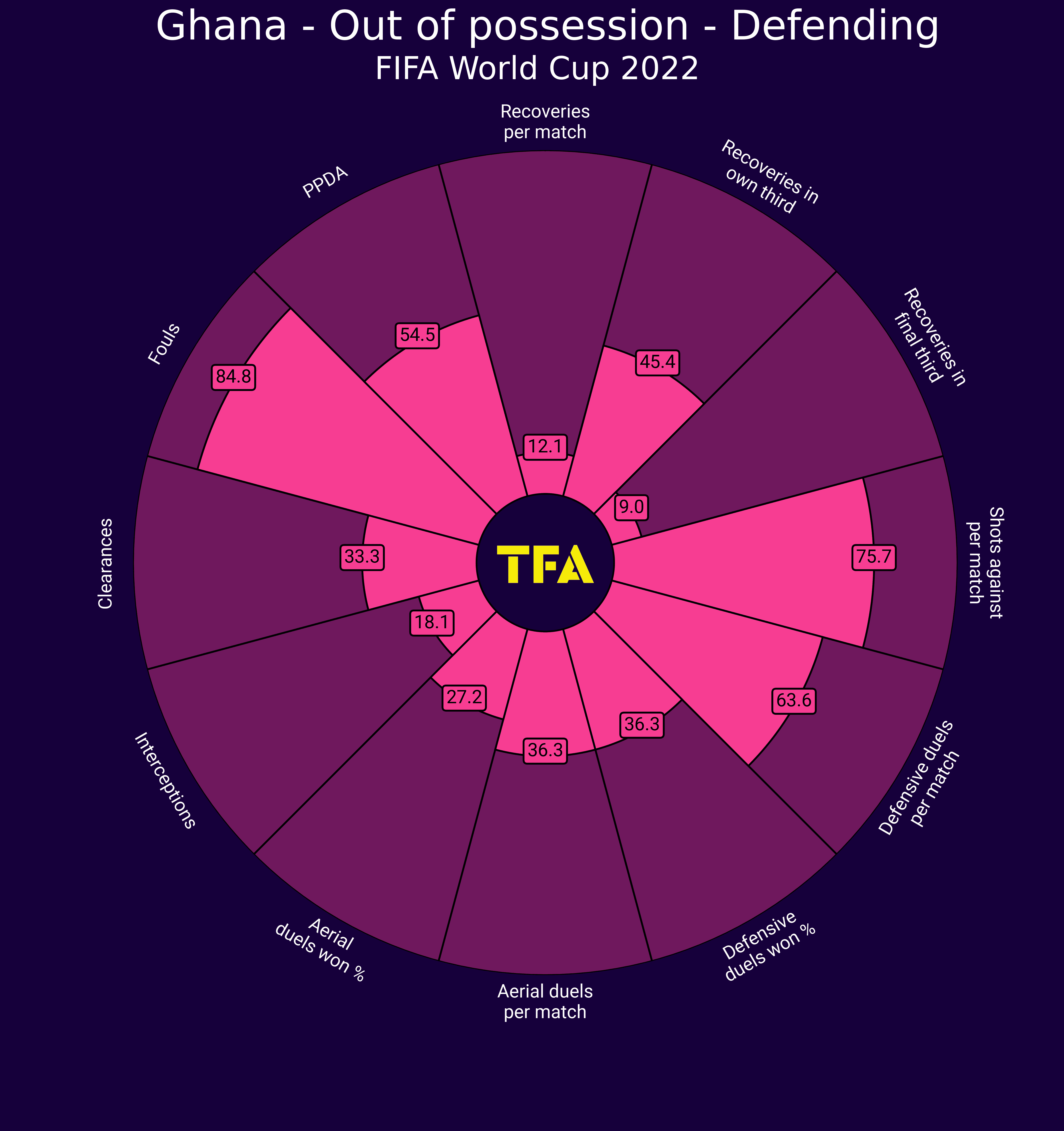
With their inconsistent setup under Otto Addo in recent international breaks, Ghana have defended in a 4-5-1 and a 5-1-2-1-1 shape with a diamond midfield. The Black Stars will likely line up with four defenders and deploy the 4-5-1 structure. Their 4-5-1 is a mid-block with attacking midfielder André Ayew dropping in alongside Mohammed Kudus ahead of pivot player Thomas Partey.
This structure does leave the striker isolated and is much better suited to a mid-block or a low-block rather than a high-pressing approach against opposition build-up. In deeper phases of opposition possession, the striker is mainly responsible for preventing access to the opposition pivot player.
The image below displays Ghana’s 4-5-1 shape against Brazil. Striker Felix Afena-Gyan has been bypassed by Brazil’s centre-backs combining but is recovering by supplying pressure from behind on the ball carrier. In this example, Mallorca’s Iddrisu Baba is the pivot player with Kamaldeen Sulemana and Jordan Ayew narrowly positioned as the right and left winger respectively.
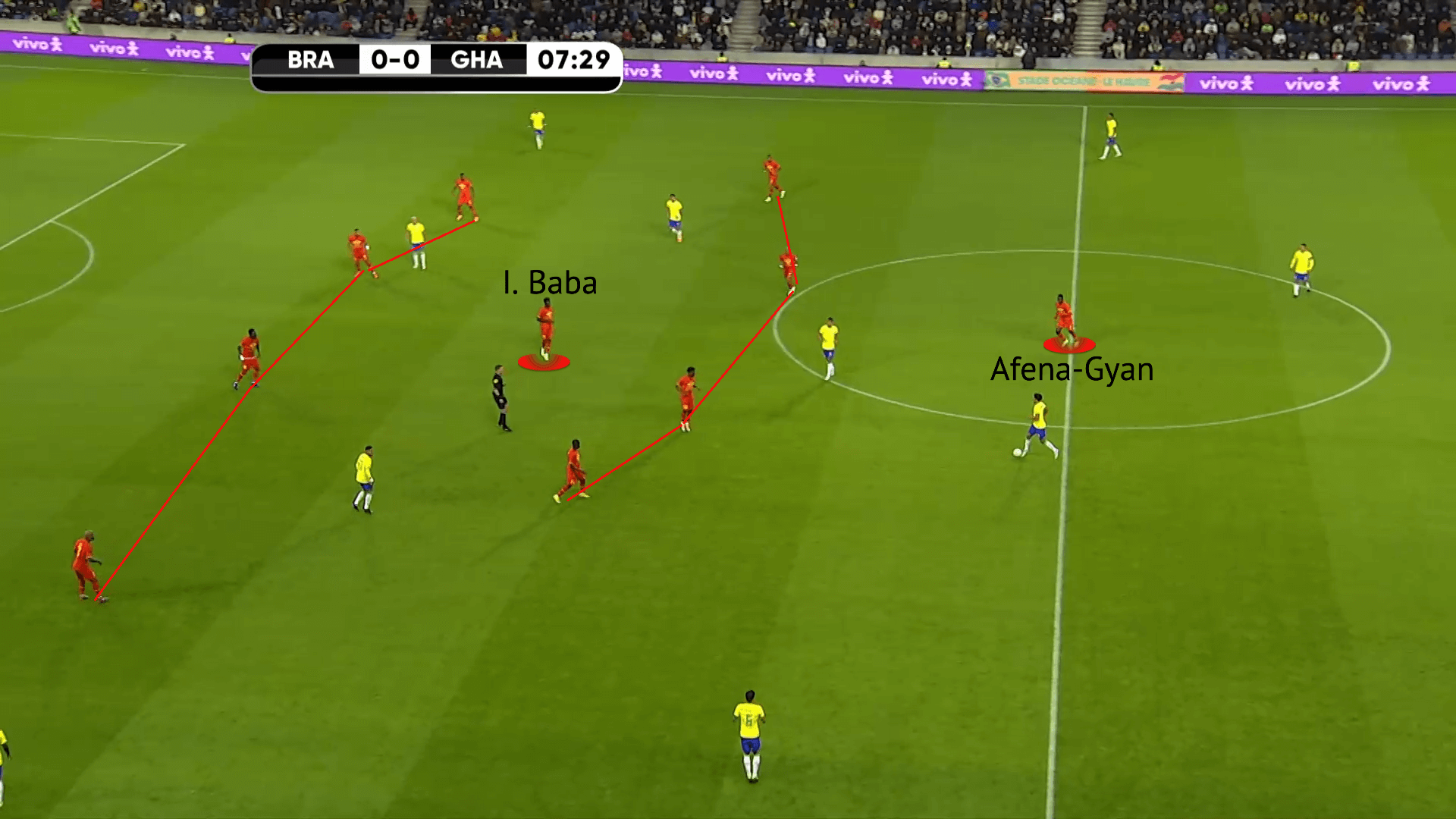
The wingers’ narrow positions ensure numerical superiority in central areas and would be effective against Portugal’s João Cancelo with his tendency to invert from full-back. The 4-5-1 prevents direct access to the half-spaces, forcing play wide. The midfield players can also block threatening spaces with cover shadows, as shown by Sulemana with Neymar. The staggering of the midfield, with Baba deeper, can also assist in winning back possession through jumping or a more man-oriented approach with the pivot player filling in vacant spaces if a central midfielder presses.
However, the narrow winger positioning can be exploited by quick passes from the full-back into an attacker between the lines. Brazil began to utilise left-back Alex Telles to quickly access Neymar’s brilliant off-the-ball movement into unmarked territory away from holding midfielder Iddrisu Baba before Ghana could shift across. This eventually prompted an in-game switch to the 5-1-2-1-1 shape from Otto Addo. Nevertheless, the compactness that the 4-5-1 can provide facilitates more aggression from the full-backs or centre-backs. This would suit the assertive, front-foot defensive styles of Mohammed Salisu and Alidu Seidu for example.
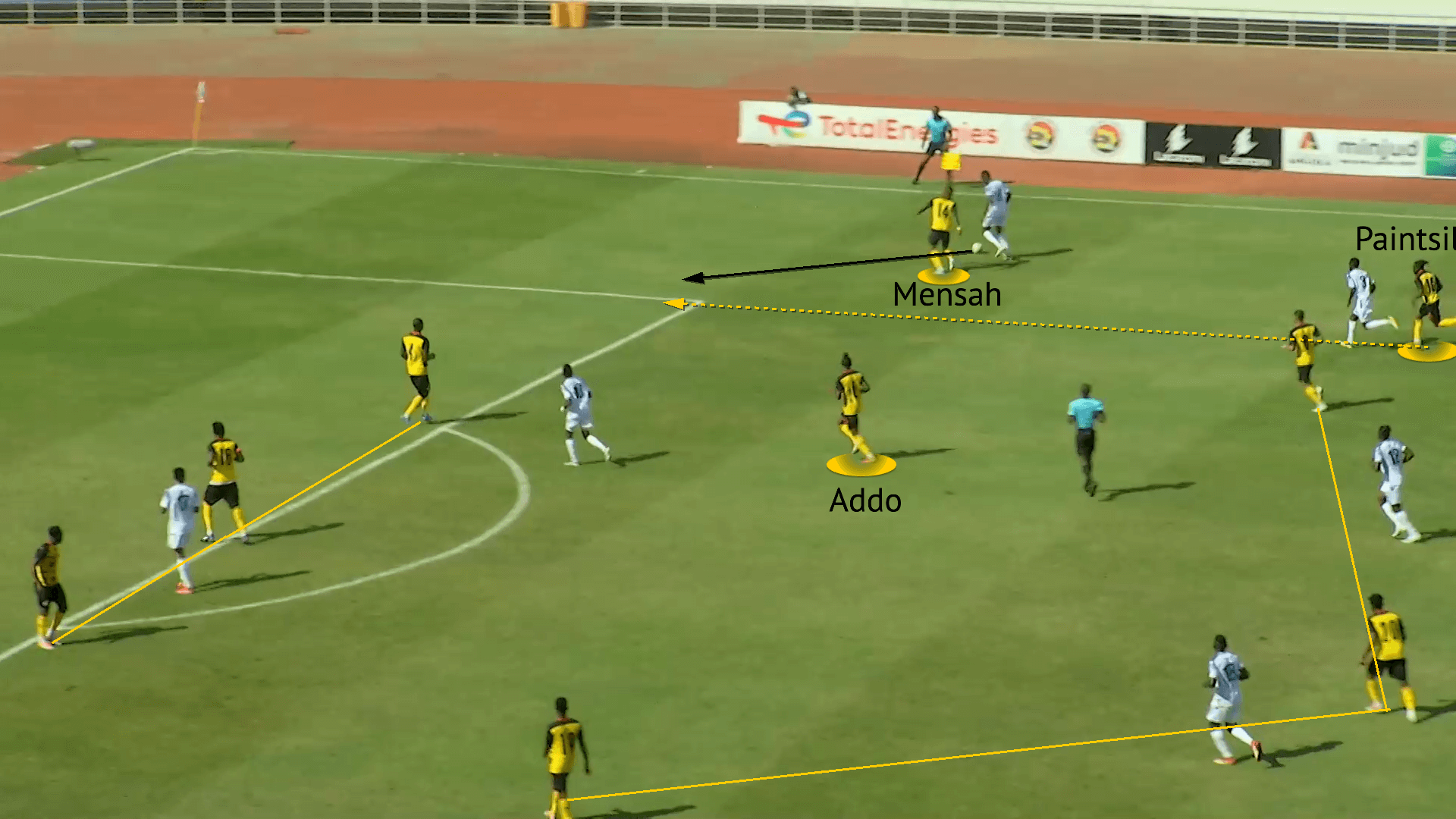
As mentioned above, the 4-5-1 can allow the full-backs to jump and aggressively press the ball carrier. In the example above against the Central African Republic, left-back Gideon Mensah has left the defensive line. Typically, in these situations, the Black Stars’ ball-side winger and central midfielder will create a 3vs2 overload in the wide areas.
However, ball-side midfielder Daniel-Kofi Kyereh hasn’t fully committed to defending, forcing winger Joseph Paintsil to follow the opposition’s underlapping run. Genk’s Ghanaian winger displays excellent defensive work rate to recover possession.
The 4-5-1 shape is easy for the full-back and winger to double up against an opposition wide player. The winger could also drop in to make a back five, the sort of scenario that benefits from fielding Tariq Lamptey as the right-winger, although Jordan Ayew’s defensive work is commendable.
Paintsil’s tracking back also allowed the centre-backs to remain inside the box rather than hesitating and then getting drawn towards the ball. In the five-at-the-back structure, the wide centre-backs will have additional numbers inside the box so are free to jump to press the underlap.
Pivot player Edmund Addo can also stay centrally and drop into the box instead of moving wide thanks to Paintsil’s recovery run. This is useful as Ghana tend to prioritise intercepting crosses across the face of goal rather than cutbacks to the penalty spot, which the holding midfielder would now cover.
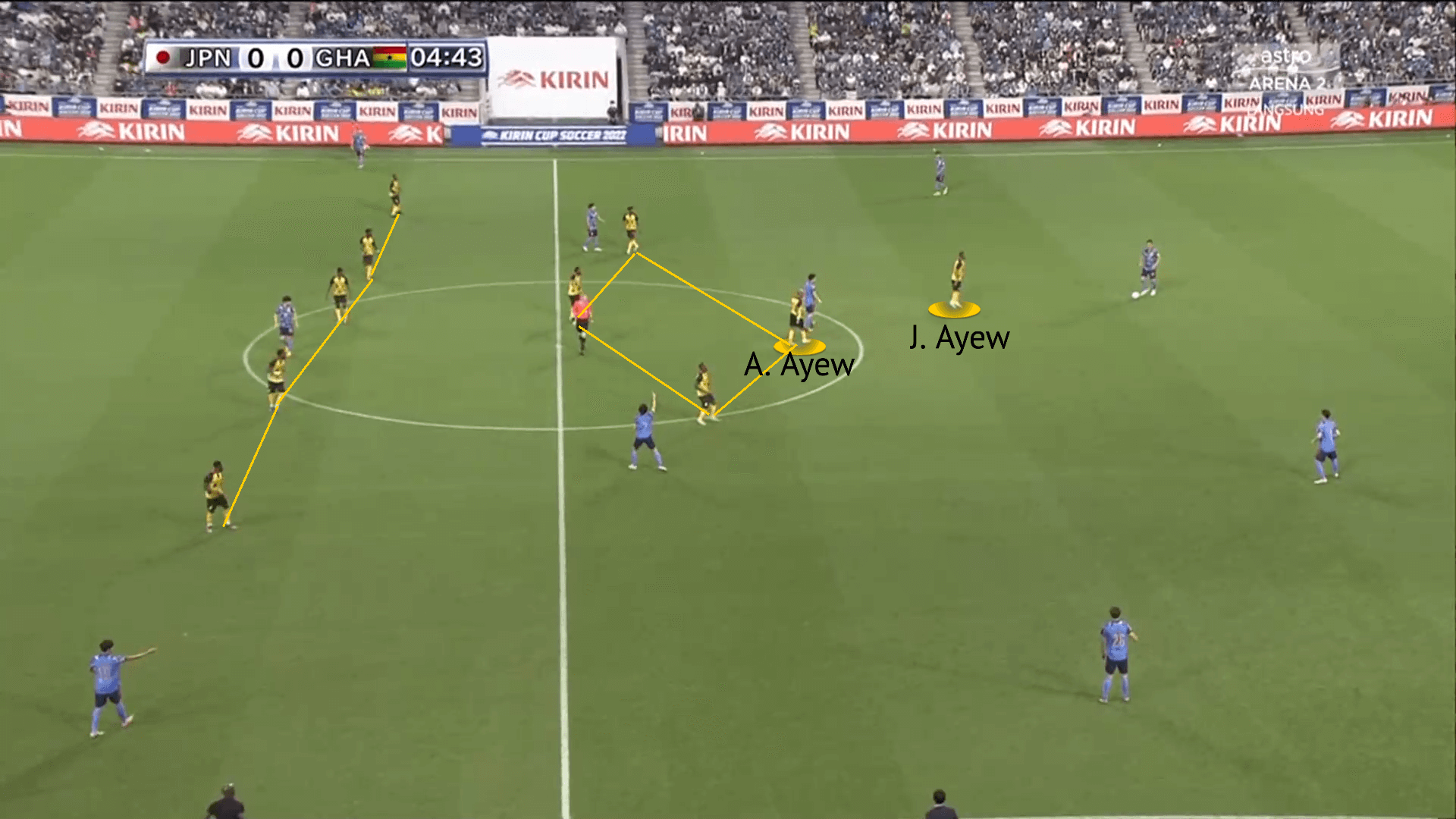
The image above displays the five at the back with a diamond midfield that Ghana deployed against Japan and in the second half against Brazil. The Black Stars still have a narrow midfield but less ability to overload the centre of midfield due to the additional player in the defensive line.
Three centre-backs provide more cover behind the full-backs who jump wide to press the opposition winger when the ball is played. The opposition full-backs are allowed the ball more so than the 4-5-1 before pressure is applied. However, the player at the tip of the diamond, André Ayew in the example above, is solely responsible for man-marking the opposition’s pivot player.
This could be useful against Portugal’s Rúben Neves and his ball progression quality, but the space conceded elsewhere could be punished by their other qualities.
The 5-1-2-1-1 seems a contingency plan for Otto Addo when he wants more defensive solidity, but more of a 5-4-1 shape would increase space occupation out of possession.
Ghana’s ability to prevent vertical passes to break the midfield line could be effective against Uruguay and Portugal, who typically try to attack with a more direct approach rather than being possession-heavy which the Black Stars set-up could force upon them.
Contrastingly, South Korea are statistically one of the leading nations at the World Cup for ball retention so will have the patience to work the ball around despite the comparative drop in quality.
Transitions
In the last year, Ghana have averaged 1.36 counterattacks ending with shots per game. 21.3% of their overall counterattacks end with shots. In comparison, they allow the opposition to have 1.29 counterattacks ending with shots per game, but the opposition are able to unleash an effort on goal from 44.2% of their counterattacks.
In attacking transitions, the Black Stars are keen to progress the ball through ball-carrying. If the midfield area is congested, they will look to combine and find a forward pass to a teammate who can receive and drive forward in space.
When space is available after regaining possession, the ball carrier will drive forwards and dribble with supporting numbers and movement ahead of the ball. Upon entering the final third, Ghana will look to release the ball to a wide player before delivering a pass infield.
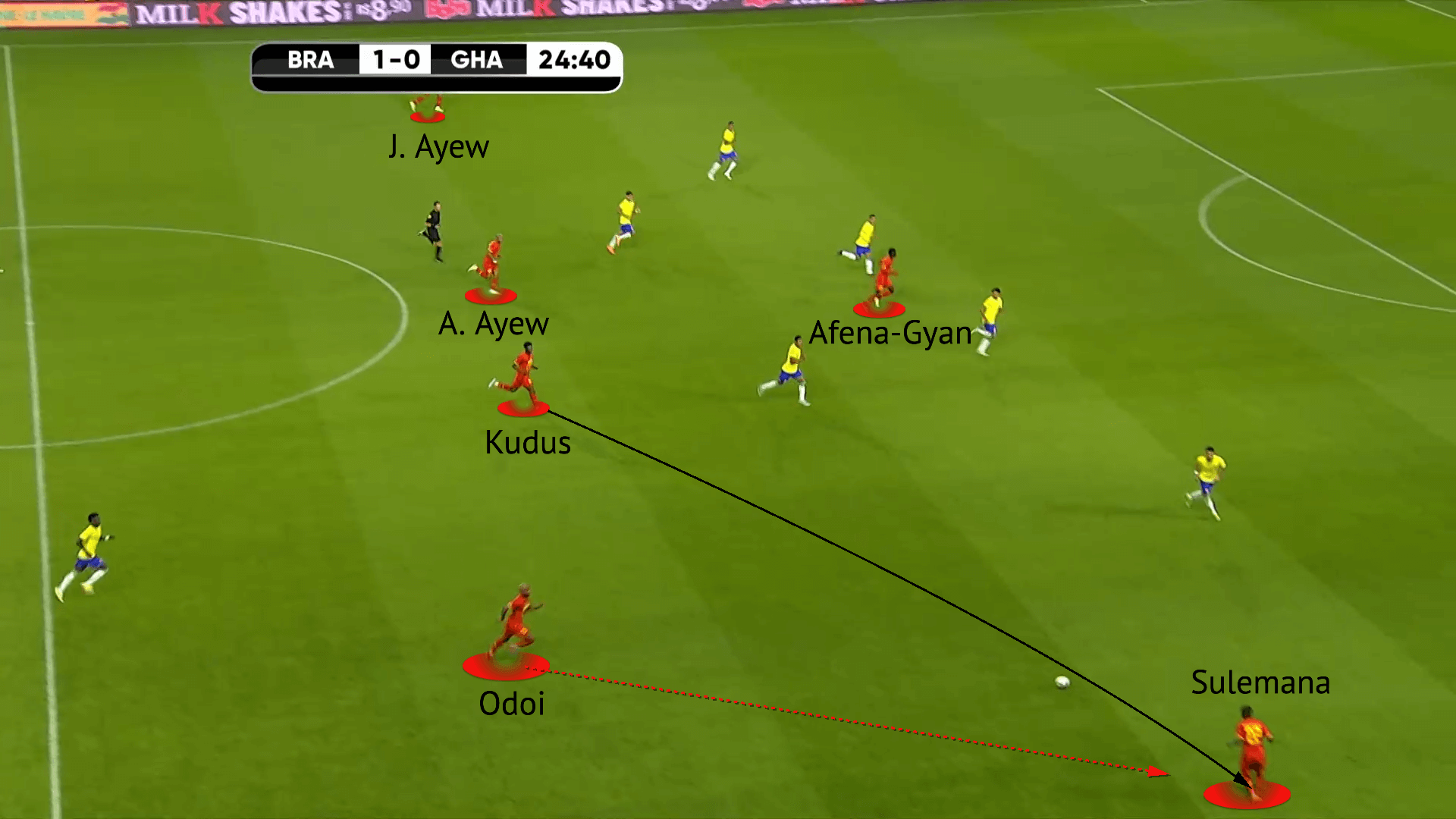
In the above example against Brazil, Ajax midfielder Mohammed Kudus has carried possession into the opposition’s half. Striker Felix Afena-Gyan has remained ahead of the ball to occupy the centre-backs with wingers Jordan Ayew and Kamaldeen Sulemana staying wide. André Ayew is adding support in central areas and right-back Denis Odoi is powering forwards to overload the wide area.
Sulemana receives possession and begins to drive at the defence with Odoi providing an overlap. Drawing Casemiro out, Sulemana returns the ball to Kudus who spreads play to Jordan Ayew, but the Crystal Palace man dawdles and his cross is blocked.
When defending transitions, Ghana will always look for at least one player to provide pressure to the ball carrier. In central areas, a central midfielder will attempt to hound the opponent in possession. In wider areas, the full-back frequently jumps out to close down space the opponent attacker can receive in.
However, the full-back can have a dilemma against an opposition winger ahead of the ball. The full-back can be pinned by the winger’s positioning and leave the ball carrier to a teammate, or they press the ball carrier and leave the winger free.
In the image below, Nicaragua created a triangle on the left with Ghana right-back Alidu Seidu getting drawn out of position to press the Nicaragua left-back. Nicaragua can play around Seidu, finding the central midfielder that is goal-side of Abdul Fatawu Issahaku to access the left winger in space. Ghana’s centre-backs will remain back in rest defence with their holding midfielder generally also staying back.
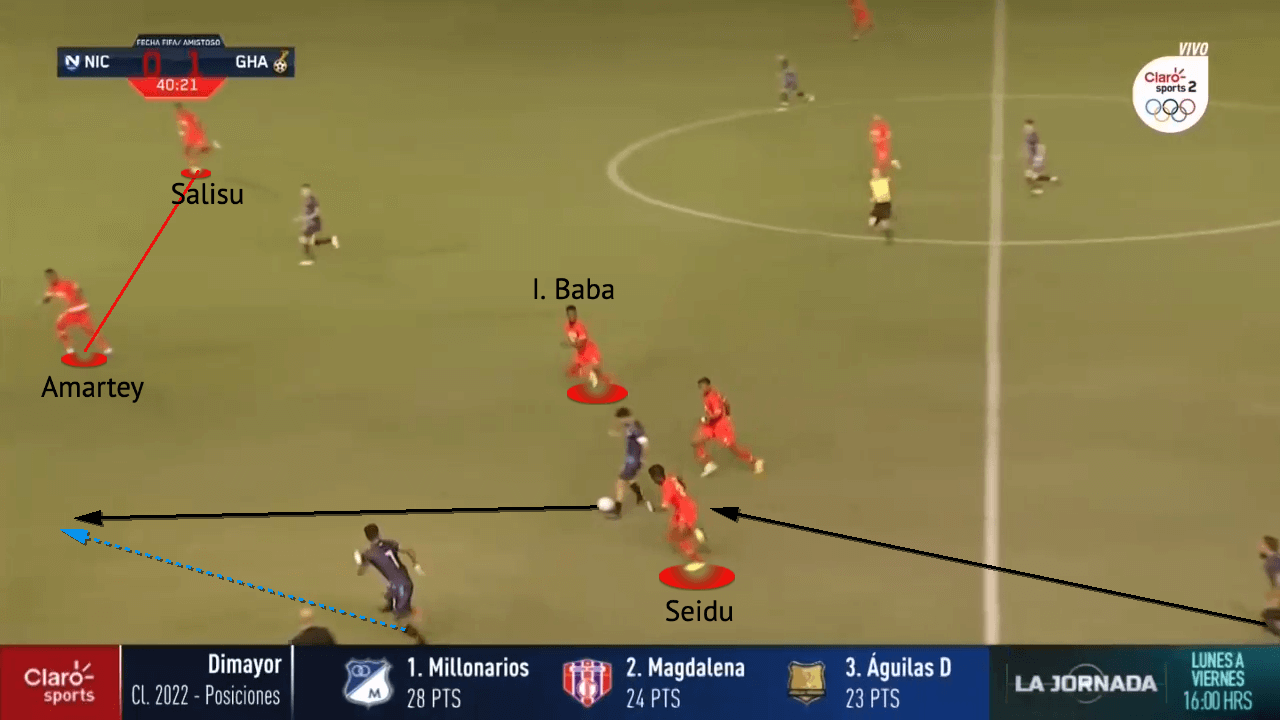
Attackers
The experienced brothers of Jordan and André Ayew will be joined in the Ghana squad by youngster Kamaldeen Sulemana and Spanish recruit Iñaki Williams. Sporting CP’s 18-year-old wonderkid Abdul Fatawu Issahaku, arriving after success with Dreams FC in the Ghana Premier League, will be selected as Otto Addo’s favoured left-footed right winger. Cremonese centre-forward Felix Afena-Gyan is also expected to represent the Black Stars in Qatar.
Winger Joseph Paintsil has started the season in spectacular form for Belgian side KRC Genk and deserves to return to the squad. Osman Bukari of Red Star Belgrade (Crvena Zvezda) is another talented winger likely to be named in the 26-man squad.
German-born Ransford-Yeboah Königsdörffer and English-born Antoine Semenyo may battle to be named as Otto Addo’s versatile attacker, despite only being chosen for one camp so far, after both scoring a few times already this season. Hearts of Oak winger Daniel Afriyie Barnieh looks unlikely to be called up, though he looks to be the strongest possible Ghana Premier League addition to the squad.
Midfielders
Arsenal’s Thomas Partey and Ajax’s Mohammed Kudus will be starters for Ghana at this World Cup as two standout stars. Freiburg’s Daniel-Kofi Kyereh has started the season strongly after his summer transfer from FC St. Pauli. Kyereh offers some more attacking quality from midfield, similarly to Kudus, and prefers to operate behind the striker. Iddrisu Baba of Mallorca provides steel with his excellent defensive duelling.
The Belgium-based duo of Gent’s Elisha Owusu and Eupen’s Mubarak Wakaso offer different qualities to the Black Stars midfield. Owusu is more technically secure whereas Wakaso is more of an energetic ball-winner in midfield. However, only one player may go to Qatar with RC Lens midfielder Salis Abdul Samed reportedly receiving his first call-up ahead of the World Cup.
Salis Abdul Samed has settled in at Lens brilliantly with his ball retention in possession and dogged pressing to regain when out of possession. Edmund Addo of FC Sheriff Tiraspol is yet to appear for the Moldovan side this season after his transfer to Red Star Belgrade fell through.
Primarily a defensive midfielder, Addo has appeared all over the pitch from the forward line to the defensive line. His versatility is best utilised as a centre-back or right-back and could be a useful asset for the Black Stars.
Defenders
Southampton’s Mohammed Salisu, Leicester City’s Daniel Amartey and Strasbourg’s Alexander Djiku will be Otto Addo’s three main centre-back choices. Amartey’s leadership is unrivalled in the Ghana defence and has developed a strong partnership with Djiku. Salisu is the best centre-back, but his only recent decision to play for Ghana may have hindered his likelihood to start.
Celta Vigo’s Joseph Aidoo has been a consistent performer for the Spanish club but has struggled for game time with the Black Stars. Aidoo has been ever-present for Celta Vigo this season but will be contesting for a spot at the World Cup with Rayo Vallecano’s Abdul Mumin and Clermont Foot’s Alidu Seidu. It wouldn’t be a surprise to see Seidu in the 26-man squad, a defensively solid player capable of playing at right-back too.
At right-back, expect to see two recent additions in Brighton’s Tariq Lamptey and Club Brugge’s Denis Odoi. Reading captain Andy Yiadom may feel unlikely to have been replaced so close to the World Cup, but that ruthlessness is required to bring more quality to the World Cup squad.
Yiadom, like Lamptey and Odoi, is a strong ball carrier but cannot compete against Lamptey’s end product and Odoi’s defensive solidity. His Reading teammate Abdul Rahman Baba is a well-rounded option at left-back and will join Auxerre’s Gideon Mensah as Otto Addo’s two left-backs without injuries. However, Abdul Rahman Baba is very injury-prone, which could lead to the selection of Ghana Premier League player Dennis Korsah from Hearts of Oak.
Key Player
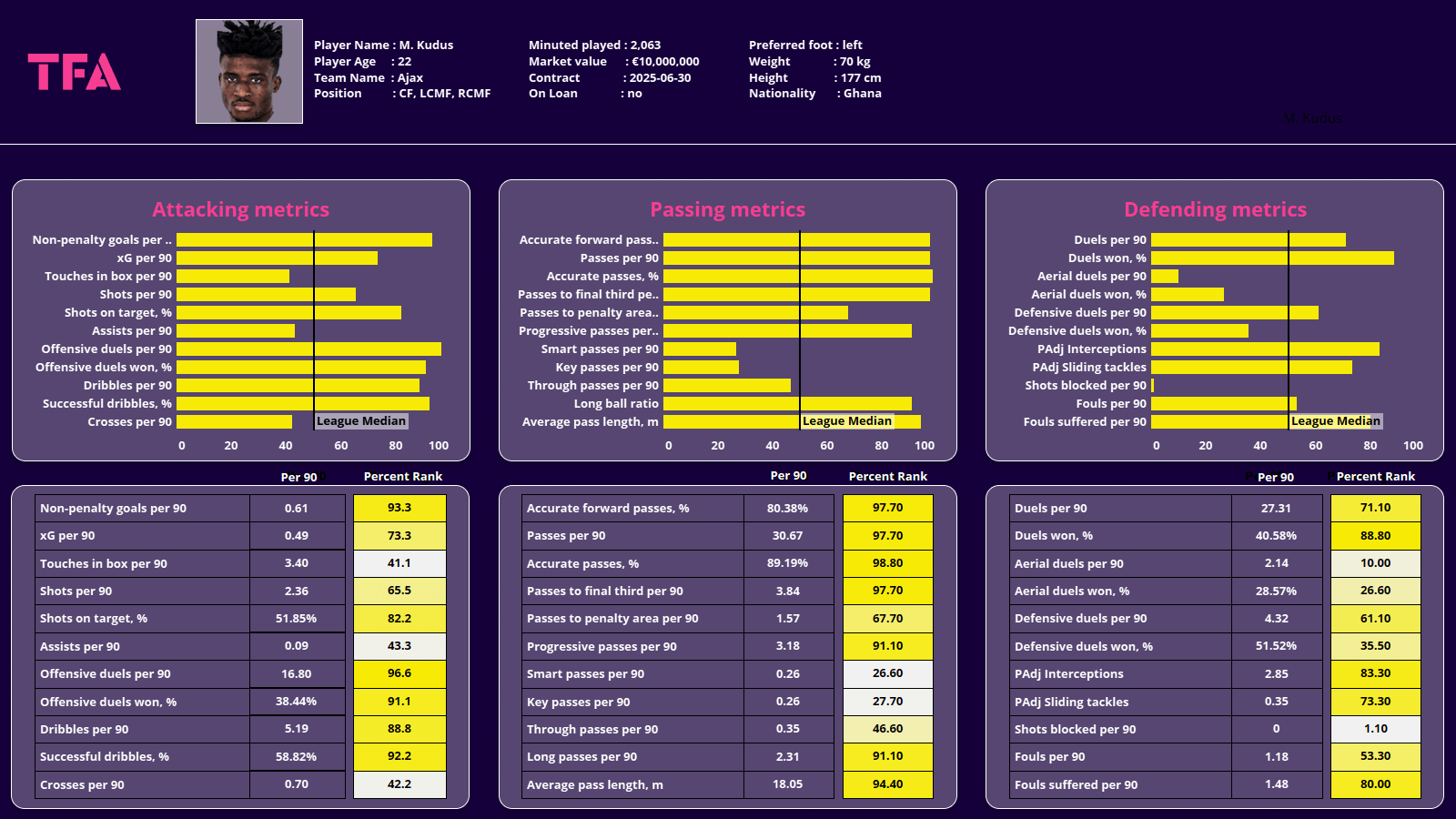
Mohammed Kudus (177cm/5’10”, 70kg/154lbs) is a versatile left-footer playing his club football with Eredivisie reigning champions Ajax. The talented midfielder has actually started the season as a centre-forward and is on fire, scoring nine goals already.
Despite the exceptional goal-scoring form, it is clear through his questionable run-making and consistent offsides that he’s a useful striker option but is still best used in a deeper role. Black Stars assistant coach Dramani Mas-Ud Didi also coached Kudus with the Right to Dream Academy and FC Nordsjælland, and said that Kudus has developed various aspects of his game by playing in different positions.
As a result, we will likely see the Ajax man operating in a deeper role for Ghana at the World Cup. Kudus is excellent at receiving possession in tight spaces before turning and driving forward, offering another route of ball progression. His new-found potency in front of goal is an additional goal-scoring threat from midfield for the Black Stars.
Meanwhile, his defensive work is also under-appreciated with his burst of speed rewarding his pressing intent to regain possession. Alongside Arsenal’s Thomas Partey, Kudus has also displayed good passing range to access Ghana’s wide players.
Tournament Prediction
Facing a typically well-drilled South Korean side, an experienced yet vibrant Uruguayan team and a Portuguese squad littered with world-class talent, a group-stage exit is likely for Ghana. However, the Black Stars do have quality themselves that could win them games, especially with the new players in the squad.
Southampton’s Mohammed Salisu enters the squad as the best centre-back, although he may not be selected as a starter. Tariq Lamptey and Denis Odoi have levelled up the right-back spot and provide different options. RC Lens’ Salis Abdul Samed offers more steel in the midfield and could potentially form a solid double pivot alongside Arsenal’s Thomas Partey. Finally, Spanish-born striker Iñaki Williams can create chaos in the final third and create a chance from nothing as a physically excellent outlet.
The Ghana squad that Otto Addo has available is more than capable of acquiring results at the World Cup, but maybe a few additional months with the new players to create a new, consistent style of play would have transformed this side into a team ready to rival the Black Stars heroes of 2010.

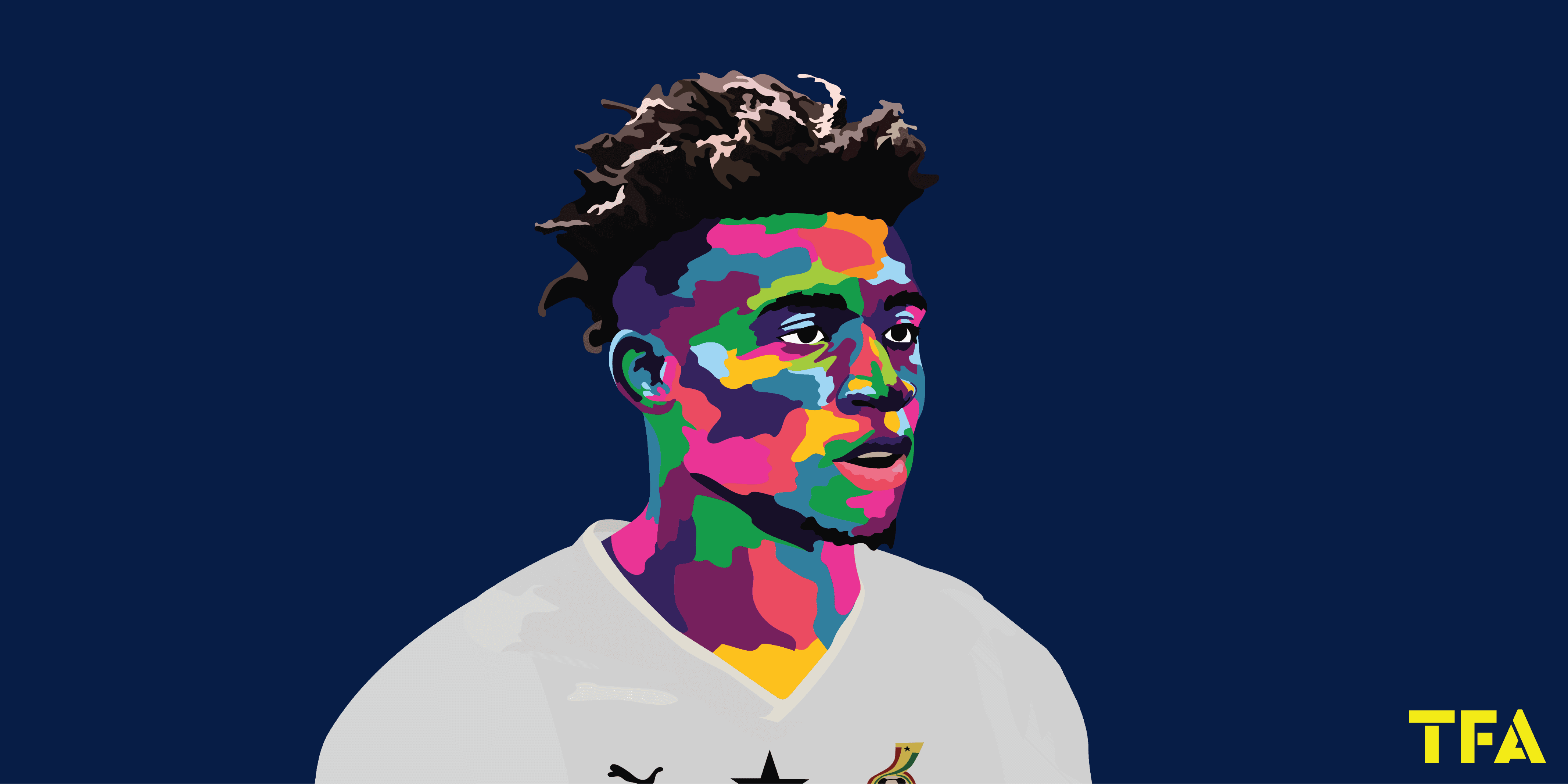




Comments